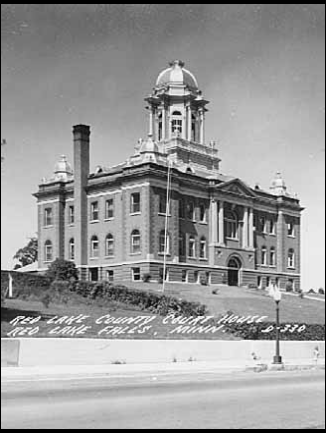 |
|
|
|
(The following is taken from "The Old Crossing Treaty" by John Saugstad, in The Old Crossing Treaty Memorial - Dedicatory Exercises, the program for the dedication of the Old Crossing Treaty Monument, June 25, 1933.) |
|
This message was passed on to the respective bands by the United States agents, the Indian chiefs and headmen together with a command from the Chiefs to assemble at the Old Crossing of the Red Lake River during the middle part of September, 1863.
At about the middle of September, the Red Lake bands of the Chippewa Indians assembled at the designated crossing and there pitched their wigwams. With them came U. S. Agent Morril (Ashley C. Morril). To this same place came the official party with Alexander Ramsey, representing the U.S. Government, escorted by a small detachment of U. S. soldiers and pitched their tents on the 21st day of September. On the 23rd of September the Pembina band of Indians arrived and the first session of the treaty council was held that day.
The two Indian bands were encamped on a beautiful, grassy lowland near the Red Lake River, and only a short distance from the ford or "Old Crossing" . The white men were encamped on a small hillock between the two Indian bands.
For about two weeks or until October second the chiefs and headmen bargained and discussed the terms of the treaty, always seeking better terms and conditions for their respective bands. On October first all chiefs had agreed to the terms of the treaty except Chief May-dwa-gun-on-ind, of the Red Lake bands, who steadily opposed the terms and when the chiefs left the council on the evening of October 1 st " all hope of effecting a treaty with the Red Lake Indians seemed to be at an end." The following day, however, the council assembled again without May-dwa-gun-on-ind, and after some further discussion lasting about three and one-half hours, Red Lake Chief, Mons- o-Mo "touched the pen". Five other chiefs, eight warriors and one head warrior followed him in signing as did the commissioners, Alexander Ramsey and A. C. Morril, and witnesses. This was October 2nd, 1863.
On October 3rd the treaty goods, presents, flags, and provisions were distributed, and" on the fourteenth day from our arrival at the treaty grounds, the expedition started on its return home".
Thus the Red Lake and Pembina bands of the Chippewa Indians ceded to the United States of America that most wonderful and fertile land that became known as the "bread and butter basket" of the nation, making it possible for thousands of families to acquire homes.
|
The ceded area is approximately 180 miles long, north and south, and approximately 127 miles wide, east and west, at the extreme length and width, containing approximately 11,000,000 acres according to Alexander Ramsey's estimate and report. For this tract the United States paid $510,000. Article One of the treaty reads as follows: "The peace and friendship now existing between the United States and Red Lake and Pembina bands of the Chippewa Indians shall be perpetual " . Thus the "Old Crossing" of the Red Lake River, where thousands of oxcarts passed, and where the making and signing of the Old Crossing Treaty occurred, is one of the outstanding historical places of Northwestern Minnesota and Northeastern Dakota, and the second day of October, 1863, has become and will remain an outstanding historical date for the states of Minnesota and North Dakota. |
|